| Your browser is not supported. | ||
|
Please browse our site using any of the following options:
| ||
How To Catch Blue Marlin
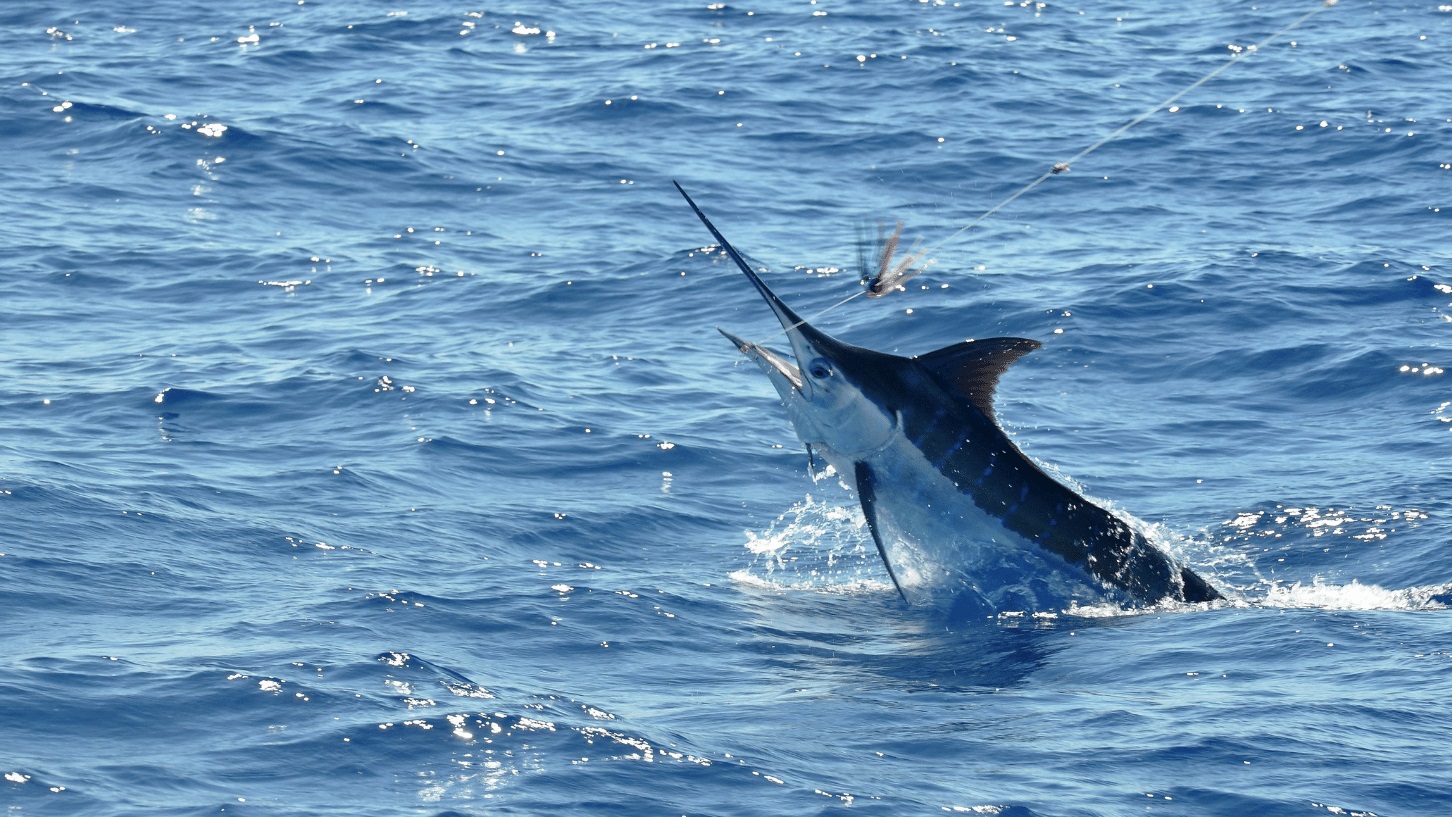
Cairns has a well-deserved international reputation for its giant black marlin, but for the rest of Australia the biggest billfish they're likely to encounter is the majestic blue. Glen Booth spills the beans on how, when and where to target these magnificent fish.
Masters of the sneak attack, blue marlin love to pounce on a trolled lure without any fanfare or warning. Barely a split second passes between the fish being sighted and the reel starting to howl, and that first run is epic. They love nothing more than getting up ahead of the boat, going berserk on the surface and dragging a big belly of line behind them. People who aren't familiar with their modus operandi usually exclaim, "Oh look, there's another one jumping over there!" Er, no. That's our fish!
The race for Australia's first officially recognised thousand pound blue was won by the West Australians in recent times, but a legitimate four figure fish is yet to be weighed on the East Coast. Some have gone very close though.
Unlike heavy tackle fishing for blacks, blue marlin are easily accessible from small boats fishing stand-up tackle, providing a few key aspects are kept in mind.
Where to find blue marlin
The vast majority of blues are caught along the Continental Shelf edge, out to as wide as you want to fish, including seamounts. They do turn up inshore at times though, periodically as shallow as 40 fathoms. Statistically, however, it's more productive to work the deeper water, concentrating efforts in and out of known canyon structure, shallow to deep and then back again, and zig-zagging along the 100 fathom line. At the end of the day the GPS plot should look like some kindergarten kid's wall scrawl. Way-pointing every bite will help to establish bite corridors over time.

Blues can turn up at any time of the year, especially in the more temperate parts of the country, but the summer-autumn period is usually the most reliable. Water temperatures over 21 degrees Celsius mean you're in with a show, but 22-26 degrees are more likely to produce.
Mutton birds shadowing skipjack or yellowfin tuna schools are definitely worth following, and any patches of flying fish breaking cover should be investigated further. Bait marking on the sounder screen shallower than 50 fathoms warrants plenty of passes, as a blue can cover that 50 fathom distance to where the lures are in just a few tail beats.
And just because the bait was deep when you drove over it doesn't mean it won't come closer to the surface during the day. Tide change, moon-rise or set, even predator activity, can trigger bait aggregation closer to the top.
Additionally, blue marlin and pilot whales have some sort of symbiotic relationship, so if you see them breaking the surface, it's always worth putting a few laps in before moving on.
Stand-up tackle
Catching a blue on stand-up tackle can be hard work, but every capture is immensely satisfying. The shorter, more powerful rods we have these days put leverage back in the angler's favour, but the correct gimbal and belt makes a massive difference too.
The key to successful stand-up fishing is to have the bucket and harness properly fitted on the angler before leaving the ramp or marina. That way, when you hit the open ocean, you're ready to fish. Don't just adjust the waist belt and expect that to get it done though. Hook it all up to an outfit and have someone load the rod up as if the angler was already fighting a fish, fine-tuning the reel straps.
So, do you wear the bucket and harness all day or not? In an ideal world, yes, but they do get annoying after a time. If, however, it's looking particularly fishy where you are, it's better to be fully kitted up - just in case.
Outriggers and riding shotgun
Outriggers assist in spreading the lines, but also help lift the heavy line/leader/wind-on/swivel combination out of the water and therefore improve lure action.
Then we have the shotgun 'rigger. This can be as simple as an outfit sitting in an overhead rocket launcher, although it can be hard to lift down when there's 8-12kg of drag and a psychotic blue marlin on the other end!
Consequently, most buy a shorter 'rigger pole, sit it in one of the rocket launcher rod holders closest to the centreline of the boat, and then put the rod in a deck rod holder where it can be easily reached.
Tag lines are an innovative way of removing as much dropback as possible, as unlike bait fishing, we want as straight a line as possible to the lure. A separate length of heavy mono with a cork ball and a piece of Dacron on the end, it is here we attach a rubber band with a slip knot to spread the line.
For 24 and 37kg tackle a #32 rubber band is more than sufficient, but it must be wrapped tightly on the line so that it doesn't slip. That way you get a clean release and the line isn't damaged by friction.
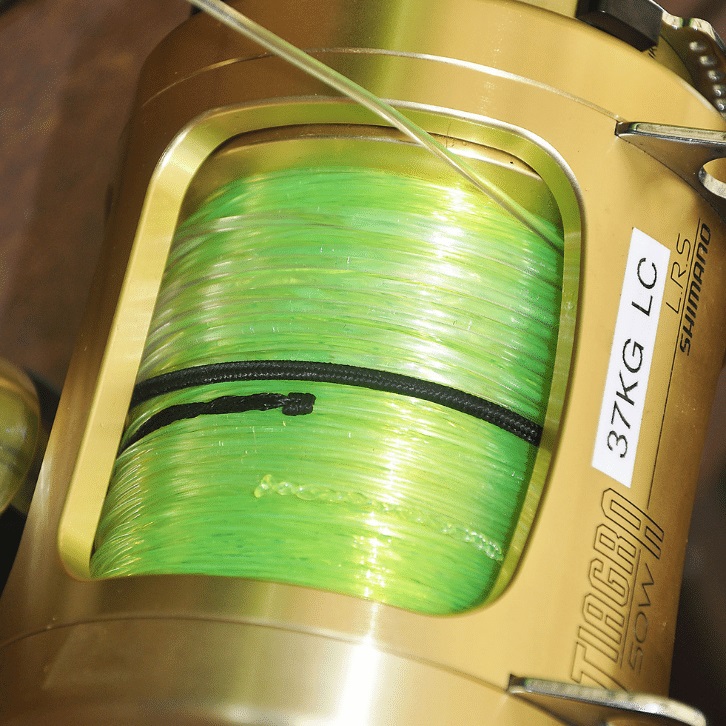

Marlin lures
Most lure head shapes, and there are plenty of them, will catch fish. Without getting into specific brands, the basic shapes we're looking at are long nosed plungers, double tapers, tubes, flat and cup faced chugger styles, plus straight runners and jetheads, with variations on these basic themes including jetted options and soft heads with realistic fish-like 'squishiness'. While bibbed and bibless minnows will get eaten, they are not renowned for producing secure hookups.
Blues love big lures, but they'll also eat something small, usually on an insignificant outfit run down the guts for mahi or somesuch. This hookup usually ends up in tears. It really is better to go loaded for bear and run a spread of lures in the 9-14" range, as that way you can get a decent sized hook and leader into them.
What goes where is really up to you, despite what some pundits might claim. If the lures are running well, smoking hard and not flicking off the top of waves, the fish will soon confirm if you're on the right track or not. Run a mix of colours to try and gauge a preference on the day, and matching local baitfish colours is a good starting point.
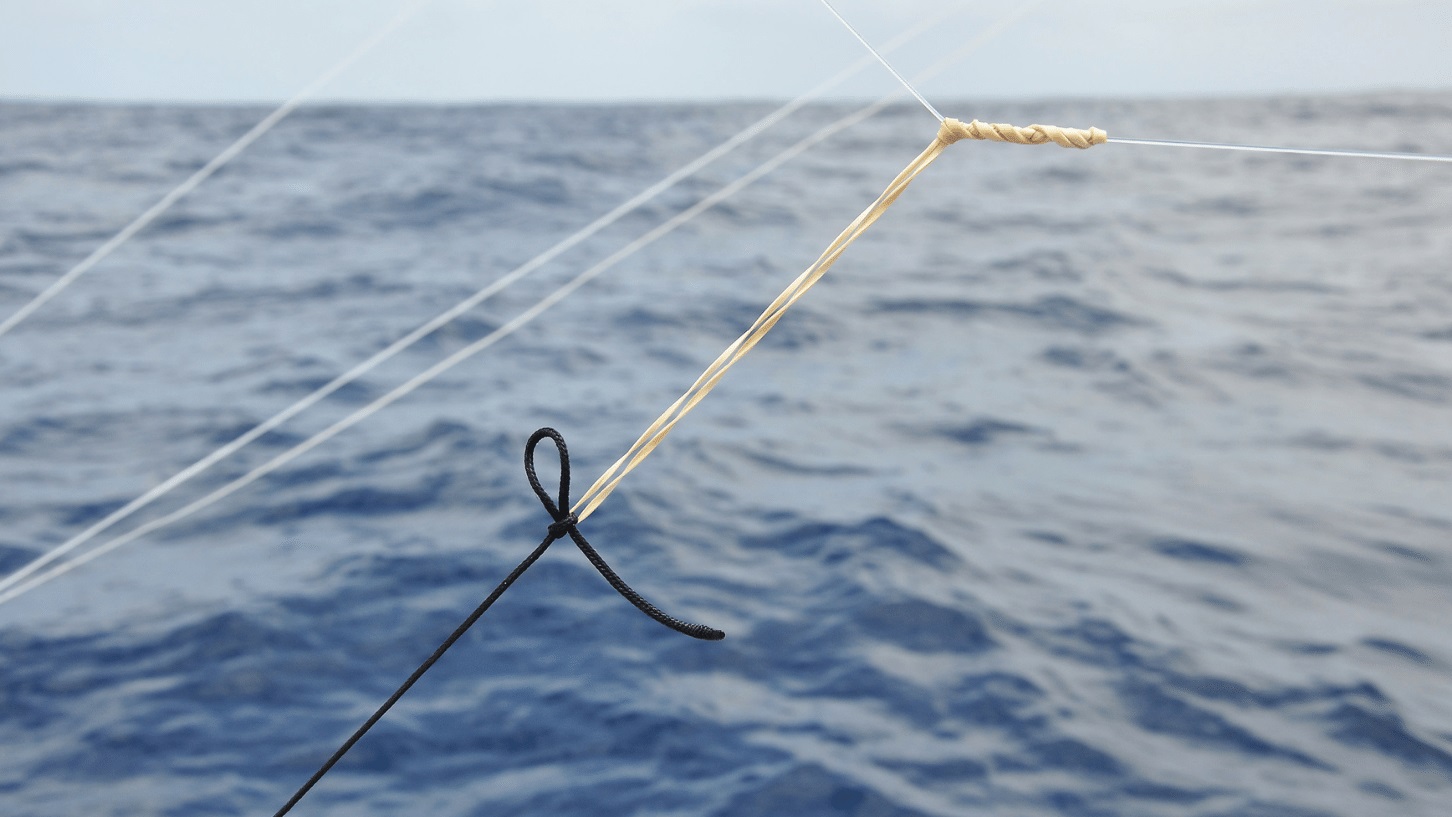
How to spread your lures for marlin
The standard spread for these wonderful shapes and colours are four lures running down the face of the third, fourth, fifth and sixth pressure waves created by the boat. In Australia they're known as the short corner, long corner, short 'rigger and long 'rigger positions. Aside from giving the impression of a loose school of fish to an approaching marlin, the spread is now evenly spaced and the skipper can turn the boat without having lines crossing over and tangling.
And then there's the shotgun position, well back behind the wake lures. Running in clear water, it's a deadly spot for something less active like a straight-running bullet shape or a jethead that just quietly mooches along, basically trying to stay out of sight! It doesn't matter to the fish though, which are quick to zoom in on this lame duck. The 'do nothing' shotty lure is also a popular target for wahoo, mahi mahi and tuna, and nobody ever complains about them.
Lures need to be adjusted in their positions to get them running at peak attractiveness. Slightly shortened up or dropped back a bit (this all varies with a change in direction, especially on rough days) will certainly pay off in more bites. And try the biggest lure on the short corner where it stands out in all the froth and commotion of the boat wake.
Any lures that look loggy or dull should be swapped out for something more active, or tried elsewhere in the spread to find their sweet spot. It will be there somewhere.
Using wind-on leaders
In a perfect world we'd all run lures rigged on long leaders with a short double, and have a deckhand muscle the fish the last little bit into tagging/gaffing range.
Unfortunately, it's sometimes difficult to recruit sufficient crew to fill the skipper/angler/wireman/tagger positions, plus there's not a lot of room for a cast of thousands in small boats. Then there's the leadering skill level to factor in. It can go horribly, painfully wrong if not done right.
Wind-ons then, are a boon for short-handed crew in small boats, as the angler is tasked with bringing the fish those crucial last few metres. With steady pressure through the rod rather than increased pressure through gloved hands, a pulled hook is also less likely. Once the tag is secured, it doesn't matter so much.
With the snap swivel at the rod tip, just make sure that the lure leader is shorter than the tag pole, otherwise it will be a struggle to reach the fish. Speaking of swivels, there's a good chance the snap will rub against the fish's body and/or tail at some stage during the fight, which can see them pop open - with tragic results.
Clips that take a serious amount of effort to open and about a size up from what you think you might need are the safest option. Wind-ons don't last forever either, and should be replaced a couple of times a season if the action is hot.
If the reel is full of new line, make sure there's room for the wind-on to comfortably fit under the spacer bar. Line needs to be wound evenly across the spool, not only during the fight, but when recovering a lure after a hook-up. Nothing destroys the Dacron and whipping on a wind-on quicker (and infuriates a skipper more) than one that's been jammed in there.
For smaller lures, hard-wearing 400lb leader is a good fit, with 500lb preferable for larger models, providing abrasion resistance without killing the lure action.
Hook configuration
Countless blue marlin have been caught on double hook rigs, but the fashion these days is towards singles, rigged with the tag end of mono twisted back up the leader to a second crimp to establish the hook position.
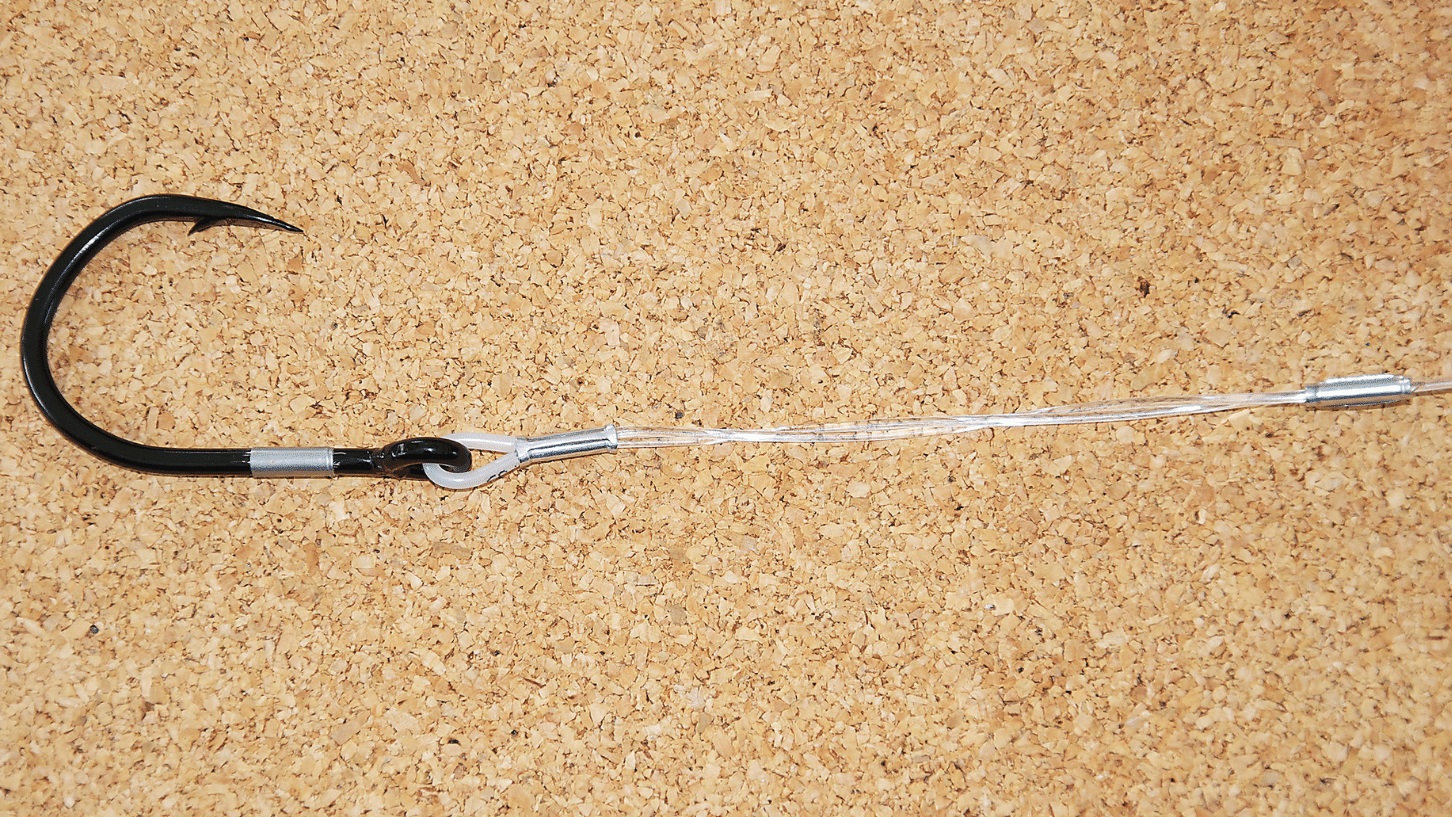
Alternatively, a short length of 650lb or greater 49-strand wire (depending on lure and hook size) creates a near impregnable hook-end. In a remarkable departure from convention, running the hook point down (rather than aiming for a roof of the mouth hookup), is gaining cred. The two working together acts like a keel to help balance the lure, but it does produce some unusual hookups outside the mouth.
Another positive with single hook rigs is that they are a lot safer for the deckie when releasing a fish boatside.
Hook positioning should be anywhere from having the point just outside the tail of the skirt to the eye of the hook just in the skirt (to keep it IGFA legal), but not buried in the skirt as it can impede the hook-set. A soft rubber bung glued behind the lure head, with the crimp pushed into it, is a great way to position the hook. It's certainly a much better approach than using toothpicks and doesn't scuff up the line.
Go hard or go home
Blues are eminently catchable on light tackle, but if you're serious about chasing them, consider 24kg line class an absolute minimum and preferably 37. If a decent fish comes along, there's enough drag range to subdue it, and smaller fish are released in better condition.
Once you get a bite, don't continue trundling along at trolling speed, as all that's doing is gifting the fish an extra 100-200m of line to play with. And gunning the boat to set the hook is a ridiculous waste of line too. If you've hooked a real screamer, you may need every centimetre of it. Ease the revs off to just above idle to keep the activity out the back, but watch for a fish that charges the boat.
Once everything has settled down and the gear is recovered, it's time to start following the line. There'll be a fair belly in it, so rather than reversing up like you're in a twin screw game boat, it's more effective to motor down the line with the angler standing at the back of the cockpit on the skipper's side. Eventually you'll be in a direct line to the fish and in a position to put some proper hurt on. After a suitable amount of time, the fish should be ready for a tag. But if it's a big fish or just an exceptionally dogged one, it's time to reach into the bag of tricks.
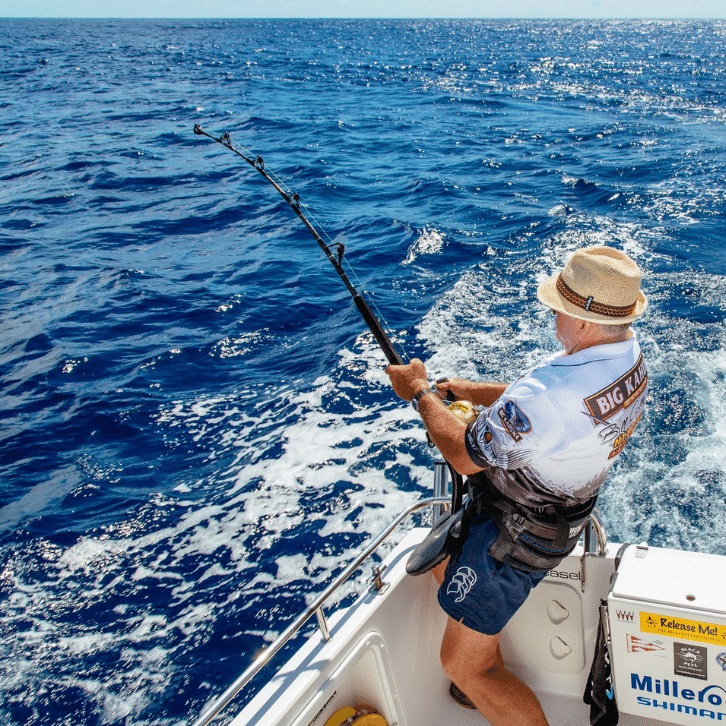
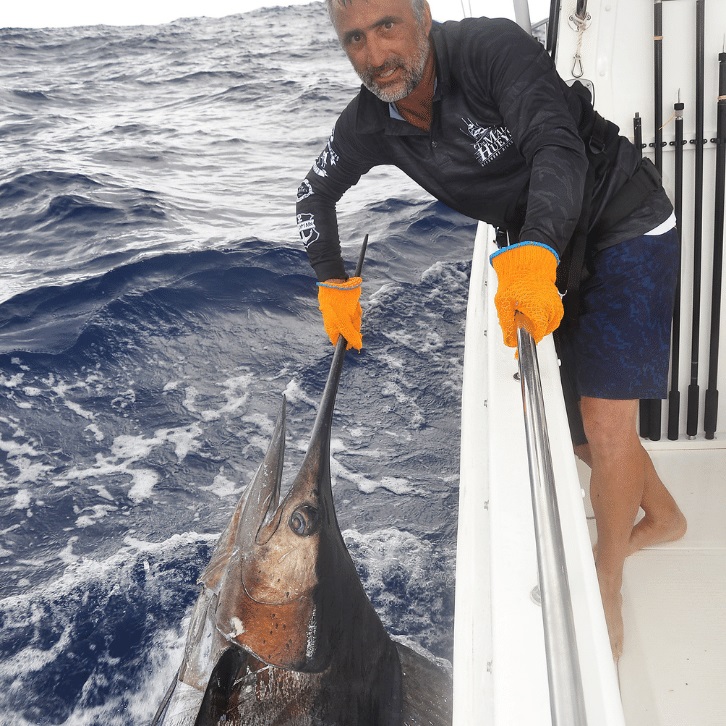
For a marlin that's not doing much except being stubborn, sacrifice a bit of line by driving off it (the angler will love this manoeuvre and will be happy to let you know all about it). Change the angle and direction of pull - anything to keep it on the hop and break it out of its comfort zone.
Is that doesn't work, it's time to increase the drag. Most fish get caught with the drag set at a third of the breaking strain of the line, which is fine for most of the time. Going onto or just beyond the button increases the pressure by a couple of kilos. If it's in the upper third of the water column, this will soon start to tell. Then, when you've broken the fish's spirit and line is coming back onto the reel, the drag can be eased back to strike or thereabouts.
You've just got to stay on the fish and wear it out with slick boat manoeuvring, drag adjustments where needed, and hard winding by the angler, because if it sounds, well that's a whole 'nother set of problems. We don't want an up and down fight stretching out for hours on end, with the fish most likely dead on the bottom in 100-plus fathoms.
If it does sound, up the drag and slowly drive off with the current (yeah, more grumbling from the angler) to create a flatter angle and plane it up. Most lever drag reels have a lower gearing (1:1 or thereabouts), so use it! It can be a slow, tortuous process, but when you can't physically get a wind in on high gear, any line coming in on low setting is considered a blessing.
Obviously, there's more margin for error with 37, but the pressure on the angler is also greater. Of course, this is all well and good if the line is fresh, but if it's last season's and you were going to re-spool but never got around to it, well, good luck with all that…
How to tease marlin to the boat
Mirror teasers, spreader bars, dredges, birds, daisy chains of squids - there's any number of teaser options out there, and they certainly add to the story behind the transom. Some crews swear by teasers while others dislike the fact that the fish can become obsessed with them, plus it's something else to pull in when you're in a hurry. And time can be of the essence when that reel is getting emptied.
Teaser reels, some manual, some electric, are often employed on flybridge boats, but teaser poles (an 'in-line' style rod without guides and an overhead reel spooled with heavy mono) are a good option for small boats. Alternatively, just use a spare outfit or two.
One new technique that resembles switch baiting, but with lures, involves running two hookless teasers from the outriggers or teaser rods, and two hooked lures on the short and long corner positions. If the marlin comes onto the teasers, after it lets go (or the crew rips it away), the fish comes roaring into the wake hell- bent on eating the first thing it sees. Alternatively, a head-rigged tuna or bridled live bait dropped in the wake as it chases the lure to the boat rarely gets refused.
Of course, this requires a level of cockpit alertness most don't possess!
After a period of time pin wheeling in the wake, most blues come to the boat pretty well spent, but there's always one that likes to liven up the final chapter. Unless they're lit up, it doesn't hurt to swim them after tagging, just to restore their equilibrium.
And always make a note of where the hook is and how it's set. It can offer up all sorts of clues as to the suitability of your rigging.
Find your local Anaconda store and check out our extensive range of fishing gear for your next marlin mission.